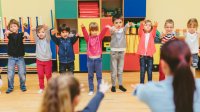Self-Regulation Strategies for Transitions
To help young students learn to manage transitions between activities, consider these simple whole class exercises.
Your content has been saved!
Go to My Saved Content.In my 15 years as a practicing school-based occupational therapist and evaluator, one of the main areas of concern I’ve identified within the academic setting centers around transitions, specifically with preschool and elementary school populations. The new school year is a big transition, so it’s important to give students supports to help them manage both big and small changes.
Consistently leading all students in the exercises and using the tools I offer below before transitioning out of the classroom or between activities should help to decrease and prevent related difficulties.
For students experiencing high levels of emotionality, transitioning can be a very difficult task. Having to exit a familiar environment, stop a preferred or familiar task, and leave that consistency can feel frightening. Providing the strategies outlined below at all transitions creates a calming routine, which is regulating, while the exercises are designed to keep students out of a fight-or-flight mode.
Smoothing transitions
Students who seem to be experiencing low energy, high energy, or strong emotions during transitions can benefit from the following suggested strategies:
- Consider creating a visual of the supports outlined below. Visuals can include images of students themselves modeling the strategies.
- The strategies can be completed before transitions and as the class is transitioning in order to keep students regulated throughout the transitioning process.
- Keep a visual of these supports by the wall next to the classroom entrance door, so that students can bring them into the class to remind them of the exercise sequences that they can utilize during the transition process to prevent dysregulation.
- One tip before having your class begin a transition after a class with high levels of physical stimulation would be to have them take a collective bubble breath or deep breath.
- It may be beneficial to engage students in an interactive and motivating game before and during transitions, such as I Spy or the Name Game.
- Consider adding the classroom job of transition leader within your classroom, providing leadership roles to your students relating to regulation. If there’s a student who consistently struggles with transitions from a physical or emotional standpoint, think about offering them the task of transition leader, teaching them how to model functional transition skills for their peers (and thus, for themselves as well). If necessary, you can pair them with a classmate to assist them in completing or modeling these strategies for the class.
Small movement exercise
Stretch and bend: Directions for students: Begin in a standing position. Straighten your legs all the way up to your hips until they feel nice and tight. Use your right arm to help you bend your left knee toward your shoulder, and hold this position for five seconds. Come back to a standing position. Use your left arm to help you bend your right knee toward your shoulder and hold for five seconds.
This is a nice activity to do before transitioning, as the balancing component provides vestibular input, decreasing fight-or-flight from an emotional and physical perspective. Focusing on the balancing component can also act as a distraction from the transition itself, thus adding a further emotional component.
Big body break
Walk and squeeze the whole body: This large movement exercise is especially helpful in relation to focus/sustained attention while participating in a motivational game. Students are grounded while keeping hands on their hips as they listen for the direction to freeze, thus addressing attentional skills. Making the body into a tight muscle incorporates proprioception, decreasing fight-or-flight from an emotional or physical perspective, while also waking up the body if there’s low energy.
Directions for students: Start in the Mountain Pose. Move your hands to rest on your hips. When your teacher or movement leader says “Freeze,” freeze your body and make your entire body into a muscle—squeezing all your muscles in your body until you feel them shake. Once you hear your teacher say “Relax,” release the muscles and place your hands back on your hips.
Tools
Sunglasses and/or a hat: Wearing sunglasses indoors can help reduce glare from bright lighting and make classes and spaces that feel overwhelming more manageable. Wearing a hat with a brim, such as a baseball hat, blocks out part of the visuals in the environment and can make students’ space feel calmer. It also can provide deep pressure to the head. Decreasing the more noxious visuals within the environment can decrease the fight-or-flight response from an emotional and physical perspective. If the hat is fitted (but not too fitted), it provides a calming compression around the head, thus also decreasing fight-or-flight reaction from those perspectives.
Directions for students: Are you bothered by bright lights or by seeing too many people or things nearby? Wearing a hat with a brim (e.g., a baseball hat) can help by blocking what you see. Make sure that it’s fitted (but not too tight). This can also make your body relax when there are too many things to see and hear by telling your body where it is. Wearing sunglasses can make bright lights less bright (think of those fluorescent bulbs), both inside and outside. This can be especially helpful when going from one place to another and there’s a lot of noise around you.
Being consistent with having students do these exercises and use the above tools before transitioning should help to decrease and even avert related issues.
